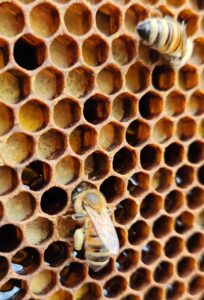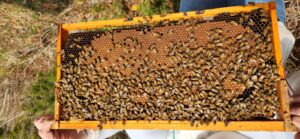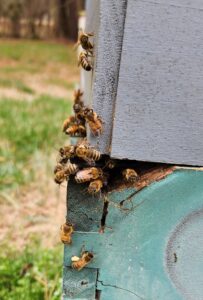What Should I Be Doing in My Apiary This Month? March
go.ncsu.edu/readext?991356
en Español / em Português
El inglés es el idioma de control de esta página. En la medida en que haya algún conflicto entre la traducción al inglés y la traducción, el inglés prevalece.
Al hacer clic en el enlace de traducción se activa un servicio de traducción gratuito para convertir la página al español. Al igual que con cualquier traducción por Internet, la conversión no es sensible al contexto y puede que no traduzca el texto en su significado original. NC State Extension no garantiza la exactitud del texto traducido. Por favor, tenga en cuenta que algunas aplicaciones y/o servicios pueden no funcionar como se espera cuando se traducen.
Português
Inglês é o idioma de controle desta página. Na medida que haja algum conflito entre o texto original em Inglês e a tradução, o Inglês prevalece.
Ao clicar no link de tradução, um serviço gratuito de tradução será ativado para converter a página para o Português. Como em qualquer tradução pela internet, a conversão não é sensivel ao contexto e pode não ocorrer a tradução para o significado orginal. O serviço de Extensão da Carolina do Norte (NC State Extension) não garante a exatidão do texto traduzido. Por favor, observe que algumas funções ou serviços podem não funcionar como esperado após a tradução.
English
English is the controlling language of this page. To the extent there is any conflict between the English text and the translation, English controls.
Clicking on the translation link activates a free translation service to convert the page to Spanish. As with any Internet translation, the conversion is not context-sensitive and may not translate the text to its original meaning. NC State Extension does not guarantee the accuracy of the translated text. Please note that some applications and/or services may not function as expected when translated.
Collapse ▲As the days get warmer, there will be more and more activity at the entrances of the hives. Honey bee colonies should be building up quickly this time of year. Get ready for swarms! It won’t be much longer before boxes get crowded and workers start making queen cells in the hopes of splitting and starting a new colony, so plan ahead. It is important to be able to predict what is going to happen before it does. For example, if there are several capped brood frames in the colony now, in just a few weeks there will be tens of thousands of new adult bees. Plan accordingly and place extra boxes on the hive BEFORE they are necessary.
Keep your eye on food stores. Pollen has been coming in from maple trees, and populations are increasing, which means the food stores may be used up much more quickly if there is another cold spell. This is a period where colonies may starve. Continue to feed sugar water if the food stores are low until there is a continuous nectar flow. Maple should be just about done blooming (in the Piedmont region), so Red Buds and Bradford Pears will be popping out soon if they haven’t already started.
Now might be a good time to reverse brood boxes as necessary. Over the winter, the cluster within the hive tends to gradually move up towards the top where the food is located. If there are two brood boxes, the bees sometimes will ignore the bottom box and become crowded in the top box. If this occurs, the beekeeper
can step in and help by swapping the two brood boxes; with the bees and brood frames now on the bottom, the bees will gradually move up and use the now empty top box. The queen has more space to lay eggs, and the colony will continue to grow. One important note here is that you need to be careful not to split up broodnest while doing this. If there is some brood on the top portion of the frames in the bottom box, do not swap the boxes. By doing so, the brood will be split up and the bees will not be able to cover all of it on cold nights.
If there are many hives in your apiary, it may be a good idea to equalize among the colonies. Coming out of winter, some will naturally be larger and some smaller. To set back some of the larger ones and keep them from swarming, it is possible to remove a few brood frames and give them to smaller colonies. This will give the smaller colonies a boost and by returning empty frames to the larger ones, it will help to set them back, give the queen more room to lay eggs, and hopefully keep them from swarming.
Depending on the weather, March is often the time for buying and installing packages or nucs. For new beekeepers, packages are the most common way of getting started. Although intimidating at first, packages are easy and fun to install. See this NCSU Bee Note for further instructions if you need a refresher on proper techniques for how to install a package. Nucs are becoming more common as a means of starting new hives. If you are buying frames of comb, remember the introduction of disease is always a possibility. Be sure you are buying from a certified seller in North Carolina and you can always ask to verify that the colonies have been inspected. The Permit to Sell Bees list of operations that are certified in NC can be found on the NCDA & CS Apiary services website.
Finally, be sure to evaluate Varroa mite levels in each colony. Most of the miticides may not be used while honey supers are on the hive. If levels are determined to be too high this early in the season, there is still time to provide control to the colonies prior to the main honey flow. The sugar shake and the alcohol wash are two techniques used to measure mite levels. If it is determined that control is needed, be sure to read labels and apply only as directed. For more information on Varroa Mite Management, see Bee Note 2.03 Managing Varroa Mites in Honey Bee Colonies.





